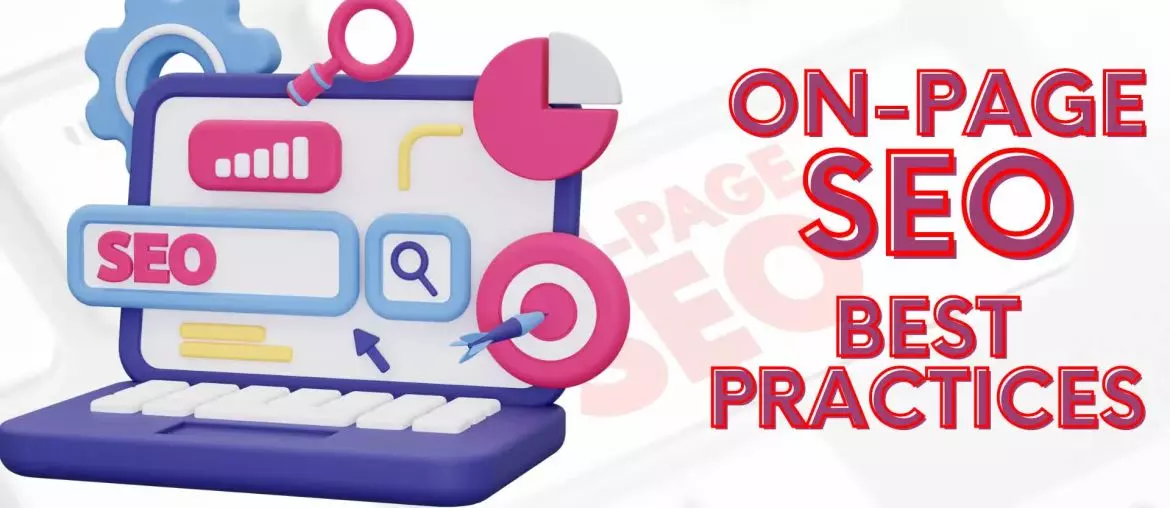On-page SEO is a crucial aspect of any successful website. It involves optimizing various elements on a webpage to improve its ranking in search engine results pages (SERPs). By implementing best practices for on-page SEO, website owners can increase their visibility in search results and attract more traffic to their sites.
Understanding on-page SEO requires a basic understanding of how search engines work. When a user enters a search query, the search engine crawls the web to find relevant content. On-page SEO focuses on optimizing elements on a website to help search engines better understand the content and relevance of a webpage. This includes keyword research and selection, content quality and relevance, title tags optimization, meta descriptions, header tags and structure, URL structure, image optimization, internal and external linking, and mobile optimization.
By following best practices for on-page SEO, website owners can improve their chances of ranking higher in search engine results pages. This can lead to increased visibility, more traffic, and ultimately, more conversions. By optimizing key elements on a webpage, website owners can create a better user experience for their audience and improve their chances of success online.
Key Takeaways
- On-page SEO involves optimizing various elements on a webpage to improve its ranking in search engine results pages (SERPs).
- Understanding on-page SEO requires a basic understanding of how search engines work.
- By following best practices for on-page SEO, website owners can improve their chances of ranking higher in search engine results pages.
Understanding On-Page SEO

The Role of On-Page SEO in SERP Rankings
On-page SEO plays a vital role in determining a page’s ranking on search engine results pages (SERPs). Google’s algorithm takes into account a variety of on-page factors when evaluating the relevance and quality of a page. Some of these factors include:
- Content relevance and quality
- Use of keywords and related terms
- Title tags and meta descriptions
- URL structure and organization
- Internal linking structure
- Use of header tags and other formatting
By optimizing these on-page factors, website owners can improve their chances of ranking higher in search results and attracting more traffic to their sites.
Core Components of On-Page Optimization
There are several core components of on-page optimization that website owners should focus on to ensure their pages are fully optimized for search engines. These include:
- Content: High-quality, relevant content is essential for on-page SEO. Pages should be written with the user in mind, providing valuable information that answers their questions and meets their needs.
- Title tags and meta descriptions: These HTML elements provide a summary of what a page is about and should include relevant keywords and phrases to help search engines understand the page’s content.
- URL structure: URLs should be short, descriptive, and easy to read, with relevant keywords included where appropriate.
- Internal linking: Linking to other relevant pages on your site can help search engines understand the structure of your site and improve the user experience for visitors.
- Header tags: Proper use of header tags (H1, H2, H3, etc.) can help organize content and signal to search engines what the most important topics on the page are.
By focusing on these core components of on-page optimization, website owners can improve their chances of ranking higher in search results and attracting more traffic to their sites.
Keyword Research and Selection

Identifying Target Keywords
Before starting the keyword research process, it’s important to identify the target audience and the purpose of the website or page. This will help in identifying the relevant keywords that the audience is searching for. One can use tools like Google Analytics, Google Search Console, and social media analytics to gain insights into the target audience’s behaviour.
Once the target audience is identified, one can use tools like Google Keyword Planner, SEMrush, Ahrefs, and Moz Keyword Explorer to generate a list of potential keywords. These tools provide information on search volume, competition, and related keywords.
Keyword Placement Strategies
After identifying the target keywords, the next step is to optimize them on the website or page. This involves placing the keywords in strategic locations such as the page title, meta description, header tags, and body content. It’s important to avoid keyword stuffing and ensure that the content is written for the audience and not just for search engines.
One can also use variations of the target keywords and related keywords to make the content more natural and engaging. This not only helps in optimizing for search engines but also improves the user experience.
Long-Tail vs. Short-Tail Keywords
Long-tail keywords are more specific and have a lower search volume compared to short-tail keywords. However, they are more targeted and have a higher conversion rate. Short-tail keywords, on the other hand, have a higher search volume but are more competitive and less targeted.
It’s important to strike a balance between long-tail and short-tail keywords and use them appropriately on the website or page. Long-tail keywords can be used for specific pages or blog posts, while short-tail keywords can be used for the homepage or category pages.
Overall, effective keyword research and selection can significantly improve the on-page SEO of a website or page. By identifying the target audience, optimizing keywords, and using a mix of long-tail and short-tail keywords, one can improve the visibility and ranking of the website or page on search engines.
Content Quality and Relevance
Creating High-Quality Content
One of the most important aspects of on-page SEO is creating high-quality content. High-quality content is essential for ranking higher in search engine results pages (SERPs) and for keeping visitors engaged on your website. To create high-quality content, it is important to understand your target audience and their needs. You should also ensure that your content is unique, informative, and actionable.
To create high-quality content, you should:
- Conduct thorough research on your topic
- Use credible sources to back up your claims
- Write in a clear and concise manner
- Use proper grammar and spelling
- Use headings, subheadings, and bullet points to break up your content
- Use images and videos to support your content
By following these guidelines, you can create high-quality content that will help you rank higher in SERPs and attract more visitors to your website.
Ensuring Content Relevance to Keywords
Another important aspect of on-page SEO is ensuring that your content is relevant to the keywords you are targeting. This means that your content should include the keywords you are targeting but in a natural and organic way. Keyword stuffing, or the practice of overusing keywords in your content, can actually hurt your rankings.
To ensure that your content is relevant to your keywords, you should:
- Use your target keyword in your title tag and meta description
- Use your target keyword in your headings and subheadings
- Use your target keyword in the first paragraph of your content
- Use variations of your target keyword throughout your content
- Use related keywords and phrases throughout your content
By ensuring that your content is relevant to your target keywords, you can improve your rankings and attract more visitors to your website.
Title Tags Optimization

Crafting Effective Title Tags
Crafting effective title tags involves creating a concise and descriptive title that accurately reflects the content of the page. A good title tag should be between 50-60 characters long, including spaces. This is the optimal length for both desktop and mobile devices.
It’s also important to make sure that the title tag is unique and relevant to the content of the page. Avoid using generic or vague titles that don’t accurately describe the page’s content. Instead, use descriptive titles that accurately reflect what the page is about.
Utilizing Keywords in Title Tags
Including relevant keywords in the title tag can help improve the page’s visibility in search engine results pages (SERPs). However, it’s important to avoid keyword stuffing, which can result in a penalty from search engines.
When using keywords in the title tag, make sure they are relevant to the content of the page and appear naturally within the title. It’s also a good idea to include the primary keyword at the beginning of the title tag, as this can help improve the page’s visibility in SERPs.
Overall, optimizing title tags is an essential part of on-page SEO. By creating effective and relevant title tags, you can improve the visibility and ranking of your pages in search engine results pages.
Meta Descriptions

Writing Compelling Meta Descriptions
Writing a compelling meta description is essential for on-page SEO. A well-written meta description can entice users to click on your link and visit your website. To write a compelling meta description, it’s important to keep the following best practices in mind:
- Use Benefit-Driven Copy: Your meta description should clearly describe the benefit someone will get from your page. It should answer the user’s query and provide a reason why they should click on your link.
- Use Action-Oriented Language: Use action-oriented language to encourage users to take action. For example, “Learn how to increase your website traffic today” is more compelling than “Our website offers tips for increasing traffic.”
- Keep it Short and Sweet: Meta descriptions should be between 120 and 155 characters. Keep your description concise and to the point.
Incorporating Keywords into Meta Descriptions
Incorporating keywords into your meta description is important for on-page SEO. Including relevant keywords in your meta description can help your page rank higher in search engine results pages. However, it’s important to avoid keyword stuffing, which can result in a penalty from search engines.
When incorporating keywords into your meta description, keep the following best practices in mind:
- Use Relevant Keywords: Use relevant keywords that accurately describe the content of your page. Avoid using irrelevant or misleading keywords.
- Use Keywords Naturally: Use keywords naturally in your meta description. Avoid stuffing keywords into your description in an attempt to manipulate search engine rankings.
In summary, writing compelling meta descriptions and incorporating relevant keywords into them are essential best practices for on-page SEO. By following these best practices, you can improve your website’s visibility in search engine results pages and attract more traffic to your site.
Header Tags and Structure

Organizing Content with Header Tags
Header tags are an effective way to organize content on a page. They allow the reader to quickly scan the page and identify the main topics and subtopics. By using header tags, the writer can break up the content into smaller, more manageable sections, making it easier for the reader to digest the information.
Hierarchy of H1, H2, H3 Tags
Header tags come with a hierarchical structure that ranges from H1 to H6. The hierarchy starts with the most important header tag: H1, at the top of the page, usually encompassing the page’s primary subject matter or topic. Subsequent header tags, such as H2 and H3, are used to denote subtopics and sub-subtopics, respectively.
It is important to use header tags in the correct order and hierarchy. The H1 tag should only be used once on a page, and it should contain the primary keyword or phrase for the page. Subsequent header tags should be used in descending order of importance, with H2 tags denoting subtopics and H3 tags denoting sub-subtopics.
Incorporating Keywords into Header Tags
Header tags provide an excellent opportunity to incorporate keywords or phrases into a page’s content. By including keywords in header tags, the writer can signal to search engines the relevance and importance of the page’s content.
However, it is important not to overuse keywords in header tags. Overuse of keywords can be seen as spammy by search engines and may result in a penalty. Instead, the writer should focus on creating informative and engaging content that incorporates keywords in a natural and organic way.
In summary, header tags are a crucial part of on-page SEO best practices. By using header tags to organize content, denote hierarchy, and incorporate keywords, the writer can improve the page’s readability and search engine optimization.
URL Structure

Creating SEO-Friendly URLs
Creating SEO-friendly URLs is all about making it easy for search engines to crawl and understand the content of a page. Here are some best practices for creating SEO-friendly URLs:
- Keep it simple: A URL should be simple and easy to understand. Avoid using complex URLs that are difficult to read and understand.
- Make it short: A shorter URL is better than a longer one. Shorter URLs tend to rank higher in search results.
- Use hyphens: Use hyphens to separate words in a URL. Avoid using underscores or spaces as they can cause confusion.
- Remove stop words: Remove stop words such as “the,” “and,” “of,” etc. from URLs. Stop words add unnecessary length to a URL and don’t provide any value to search engines.
- Use lowercase letters: Use lowercase letters in URLs. Avoid using uppercase letters as they can cause confusion.
Incorporating Keywords into URLs
Incorporating keywords into URLs is an effective way to optimize a webpage for search engines. Here are some best practices for incorporating keywords into URLs:
- Use relevant keywords: Use relevant keywords in URLs. The keywords should accurately reflect the content of the page.
- Avoid keyword stuffing: Avoid stuffing too many keywords into a URL. Keyword stuffing can lead to penalties from search engines.
- Use a hierarchy: Use a hierarchical structure in URLs. This helps search engines understand the relationship between pages and the website as a whole.
In conclusion, URL structure is an important aspect of On-Page SEO. By following the best practices discussed in this section, webmasters can create SEO-friendly URLs that help search engines understand the content of a page and improve the ranking of a webpage.
Image Optimisation

Using Alt Text with Keywords
Alt text is the text that appears when an image cannot be displayed on a webpage. This text is also used by search engines to understand the content of the image and can help to improve your website’s SEO. When writing alt text, it’s important to include relevant keywords that describe the image accurately. However, it’s also important not to stuff the alt text with too many keywords, as this can be seen as spammy and can hurt your website’s ranking.
Optimizing File Names and Sizes
The file name of an image should be descriptive and relevant to the content of the image. This can help search engines understand the content of the image and can improve your website’s SEO. It’s also important to optimize the file size of the image to improve the loading time of your website. This can be done by compressing the image without losing too much quality.
Image Title, Description, and Caption
In addition to alt text, it’s also important to include a descriptive title, description, and caption for your images. This can help to improve the user experience and can also be used by search engines to understand the content of the image. The title should be descriptive and relevant to the content of the image, while the description should provide more information about the image. The caption can be used to provide context for the image and can also be used to include relevant keywords.
By following these best practices for image optimization, you can improve the user experience and boost your website’s search engine visibility.
Internal and External Linking
 Building a Strong Internal Link Structure
Building a Strong Internal Link Structure
Internal linking is an essential aspect of on-page SEO. It refers to the practice of linking pages within the same website. A strong internal link structure helps search engines understand the hierarchy and relationships between pages on your site. It also helps users navigate your site, find relevant content, and spend more time on your site.
To build a strong internal link structure, you should:
- Use descriptive and relevant anchor text: Use anchor text that accurately describes the content of the linked page. Avoid using generic phrases such as “click here” or “read more.”
- Link to relevant pages: Link to pages that are relevant to the content of the current page. This helps search engines understand the topic of the page and the overall theme of your website.
- Use a logical hierarchy: Organize your internal links in a logical hierarchy, with the most important pages at the top. This helps search engines understand the importance of each page and the overall structure of your website.
Optimizing Anchor Text for External Links
External links, also known as backlinks, are links from other websites to your site. They are an important factor in determining the authority and relevance of your site. Optimizing anchor text for external links can help improve your site’s search engine rankings.
To optimize anchor text for external links, you should:
- Use relevant and descriptive anchor text: Use anchor text that accurately describes the content of the linked page. Avoid using generic phrases such as “click here” or “read more.”
- Vary anchor text: Use a variety of anchor text to avoid over-optimization and to make your backlink profile look more natural.
- Build high-quality backlinks: Focus on building high-quality backlinks from authoritative and relevant websites. This will help improve your site’s authority and relevance in the eyes of search engines.
In conclusion, building a strong internal link structure and optimizing anchor text for external links are essential on-page SEO best practices. By following these practices, you can help improve your site’s search engine rankings, increase traffic, and provide a better user experience.
Mobile Optimisation
Mobile optimization is a crucial aspect of on-page SEO. With the majority of website visits coming from mobile devices, it is important to ensure that your website is mobile-friendly. Here are two key aspects of mobile optimization:
Responsive Design for Mobile Devices
Responsive design allows your website to adjust to different screen sizes, making it easier to navigate on mobile devices. With responsive design, the same HTML code is sent to all devices, but the CSS changes how the page renders based on the device. This is a great way to optimize for mobile devices because it ensures that your website is accessible to all users, regardless of the device they are using.
To ensure that your website is responsive, it is important to test it on different devices. You can use tools like Google’s Mobile-Friendly Test to check how your website looks on different mobile devices. If your website is not responsive, you can work with a web developer to make the necessary changes.
Mobile Page Speed
Mobile page speed is another important aspect of mobile optimization. Users expect websites to load quickly on their mobile devices, and if your website takes too long to load, they may leave and never return. To optimize your website for mobile page speed, there are several things you can do:
- Optimize images: Large images can slow down your website, so it is important to compress them before uploading them to your website.
- Minimize code: Minimizing your code can help reduce the amount of data that needs to be downloaded, which can improve page speed.
- Use a content delivery network (CDN): A CDN can help improve page speed by caching your website’s content on servers around the world, reducing the time it takes for users to access your website.
By implementing these mobile optimization best practices, you can improve your website’s visibility on mobile devices and provide a better user experience for your mobile users.
Conclusion
In conclusion, on-page SEO is an essential aspect of digital marketing that helps to improve website rankings and visibility. By following the best practices outlined in this article, website owners can optimize their web pages for search engines and attract organic traffic.
One of the key elements of on-page SEO is keyword research. Website owners should conduct thorough keyword research to find relevant keywords and phrases that users are likely to search for when looking for information related to their niche. This will help to ensure that their web pages are optimized for the right keywords and phrases.
Another important aspect of on-page SEO is optimizing the content on the web page. Website owners should ensure that the content is high-quality, informative, and engaging. They should also use formatting such as headings, lists, bold, and italics to make the content easier to read and understand.
Finally, website owners should ensure that their web pages are mobile-friendly and have fast loading times. This will help to improve the user experience and reduce bounce rates.
By following these best practices, website owners can improve their on-page SEO and attract more organic traffic to their websites.
🌟 Supercharge Your Online Influence with Malaysia’s Leading SEO Company! 🚀 Unleash the Power of Your Digital Presence with our Expert Team. Ready to Transform Your Online Legacy? Connect with us now and Ignite Your Digital Triumph!
Frequently Asked Questions
What are the essential elements of on-page SEO?
On-page SEO involves optimizing individual web pages to rank higher in search engines and earn more relevant traffic. The essential elements of on-page SEO include optimizing title tags, meta descriptions, header tags, URL structures, content, internal linking, and image optimization.
How can I effectively implement on-page SEO for my website?
To effectively implement on-page SEO, you should start with keyword research to identify relevant keywords and phrases for your website. Then, optimize your website’s title tags, meta descriptions, header tags, and URL structures to include those keywords. Next, create high-quality, informative, and engaging content that incorporates the keywords. Finally, optimize your images and internal linking to improve the user experience and search engine visibility.
What are the top three on-page SEO factors that impact search rankings?
The top three on-page SEO factors that impact search rankings are content quality, keyword optimization, and user experience. High-quality, informative, and engaging content that incorporates relevant keywords is essential for improving search engine visibility. Additionally, optimizing title tags, meta descriptions, header tags, and URL structures with relevant keywords can help boost rankings. Finally, ensuring a positive user experience with fast loading times, easy navigation, and mobile responsiveness can also improve search engine visibility.
How does technical SEO relate to on-page optimization?
Technical SEO and on-page optimization are both critical components of a comprehensive SEO strategy. Technical SEO focuses on optimizing the technical aspects of a website, such as site speed, mobile responsiveness, and site architecture, to improve search engine visibility. On-page optimization, on the other hand, involves optimizing individual web pages to rank higher in search engines and earn more relevant traffic. Both technical SEO and on-page optimization are essential for improving search engine visibility and driving relevant traffic to a website.
What distinguishes on-page SEO from off-page SEO, and how do they complement each other?
On-page SEO involves optimizing individual web pages to rank higher in search engines and earn more relevant traffic. Off-page SEO, on the other hand, involves optimizing external factors, such as backlinks, social media, and online directories, to improve search engine visibility. While on-page SEO focuses on optimizing the content and structure of a website, off-page SEO focuses on building authority and credibility for a website through external factors. Both on-page and off-page SEO are essential for improving search engine visibility and driving relevant traffic to a website.
 Singapore
Singapore  Singapore
Singapore Malaysia
Malaysia




 Building a Strong Internal Link Structure
Building a Strong Internal Link Structure



 Keyword research is a crucial part of any SEO strategy. It helps you to understand the language your target audience uses when searching for information online. This information can then be used to optimise your website’s content and improve its search engine rankings. To get started with keyword research, you need to set up the right tools.
Keyword research is a crucial part of any SEO strategy. It helps you to understand the language your target audience uses when searching for information online. This information can then be used to optimise your website’s content and improve its search engine rankings. To get started with keyword research, you need to set up the right tools. Keyword research is a crucial aspect of SEO that can help improve your website’s visibility and ranking on search engines. Here are some steps to follow when conducting your keyword research:
Keyword research is a crucial aspect of SEO that can help improve your website’s visibility and ranking on search engines. Here are some steps to follow when conducting your keyword research: When conducting keyword research for SEO, it is crucial to evaluate the keywords you have chosen to ensure they are relevant, have an appropriate level of difficulty, and have a suitable search volume. Here are some factors to consider when evaluating keywords:
When conducting keyword research for SEO, it is crucial to evaluate the keywords you have chosen to ensure they are relevant, have an appropriate level of difficulty, and have a suitable search volume. Here are some factors to consider when evaluating keywords: Keyword research is a critical component of SEO strategy. Once you have identified a list of potential keywords, the next step is to organize and prioritize them based on your goals and
Keyword research is a critical component of SEO strategy. Once you have identified a list of potential keywords, the next step is to organize and prioritize them based on your goals and  After conducting thorough keyword research, it’s time to implement those keywords into your SEO strategy. Here are some effective ways to do that:
After conducting thorough keyword research, it’s time to implement those keywords into your SEO strategy. Here are some effective ways to do that: